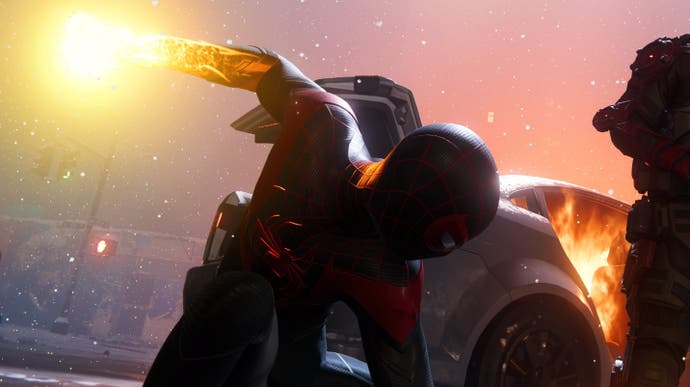Returning to Spider-Man: Miles Morales is a reminder of how a single series can really evolve its accessibility options
Shocker!
Spider-Man: Miles Morales is not a new game by this point, but it's one that still surprises me.
Spider-Man is one of my favourite superheroes, so I obviously couldn't wait to play Insomniac's Spider-Man back when it came out in 2018. The smooth freedom of web-swinging around New York City certainly released my inner friendly neighbourhood Spider-Man. However, the fast-paced combat and intense use of every button on the controller generated frustrating barriers that ultimately denied me full Spidey immersion.
As a disabled gamer, I carefully manage my energy levels, so I don't quickly experience fatigue which eventually decreases game time. This game was energy sapping, due to lacking options such as button remapping, aim snapping or toggles. These accessibility omissions meant that boss battles against two enemies working together, such as Electro and Vulture or Rhino and Scorpion, were nearly impossible and constantly reminding me of my limited abilities instead of offering a sense of escapism. (I must admit though that Spider-Man doesn't have a complicated control scheme in comparison to some of my favourite games, like Red Dead Redemption 2, GTA 5 and Cyberpunk 2077.)
So I was nervous about Miles Morales. Should I have been? Happily, that famous line about great power and responsibility has infiltrated the mindset of Insomniac, just as Miles Morales steps up to the mantle of Spider-Man. Insomniac used its great responsibility to design Spider-Man: Miles Morales for accessibility, whilst granting disabled gamers great power through next level accessibility features.
In fact, Spider-Man: Miles Morales is a true accessibility evolution of the superhero genre, reaching right down to the story itself, which explores ideas of belonging and acceptance, which greatly aligns with accessibility. More importantly, Insomniac didn't drastically tinker with the original controls, but the team cleverly implemented accessibility features on top of them. What a Shocker?
An example: button remapping in Miles Morales allows you to change button layouts, but it also shows you how remapping will affect actions that require multiple button presses. For example, I remap dodge (Circle) to select or fire gadgets (R1), allowing me to use my fastest finger to dodge. Remapping is also supported by the smart decision to navigate the gadget wheel with the left stick, letting me remap the wheel to a face button. My favourite feature is the web-shooter burst which fires 3 webs at once, so I can web criminals up like a fly in one button press instead of pressing the button 3 times. It creates a smooth transition between combat and performing the signature Spidey move without struggling to press Circle multiple times.
It all counts. Fighting Rhino in Miles Morales was quite easy in comparison with the utter nightmare of fighting him in Spider-Man. The use of toggles for aiming, Venom powers and swinging/parkour in Miles Morales thankfully reduces the fatigue I get from holding two buttons at once, without reducing access to every gameplay action. Therefore, I could effectively use Venom powers and throw environmental objects at enemies instead of completely ignoring those abilities. Elsewhere, supplementary options such as enhanced snap-to-aim eliminates the need to constantly shift your finger between aiming using the right stick and combat actions on the face buttons during combat. The increased dodge window option limits player damage by lengthening the time to press dodge for gamers without quick reflexes.

In the first Spider-Man, I still remember the first boss battle with Shocker where you must chase him around the city. I failed multiple times due to the movement speed of Shocker and the small window you have before he escapes. Miles Morales has a few boss chases too, however the Chase Assist option lowers the top movement speed of the boss, increases the escape window and automatically attaches to the chase target when within range so it's easier to attack them.
Spider-Man is known for his athletic prowess, illustrated by beautifully swinging through the city and performing air tricks. In the first game, performing air tricks was nearly impossible because you have to press both the Triangle and Circle buttons whilst moving the left stick in different positions to perform various tricks. Don't forget that you are doing these finger gymnastics whilst web swinging. In Miles Morales, you perform air tricks with the Square button and the left stick, but there are multiple nuanced options for Air Trick Mode. The option I choose is Toggle Maintain, so I press Square once to enter trick mode, which persists through other actions, and you only exit once you press Square again. The freedom it has provided me is endless as I try to perform all the tricks Miles has up his sleeve.
The utility belt of accessibility options in Spider-Man: Miles Morales were clearly designed by Insomniac from vital feedback provided by disabled gamers who struggled to enjoy or even experience the entire narrative of the first Spider-Man. Disabled gamers want options that allow them to personalise their superhero experience in games that can clearly add accessibility options, without altering core gameplay. I can't praise Insomniac enough for championing accessibility and demonstrating that intelligent accessibility design doesn't always mean huge changes but can be simple effective upgrades instead.


















